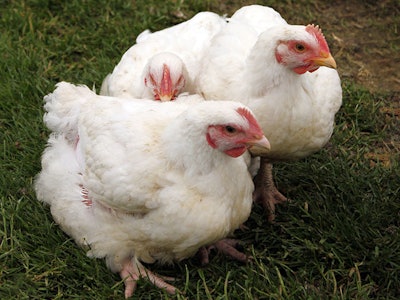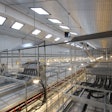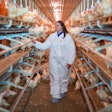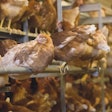
“It’s not about cost, it’s not about price to [customers]. It’s about quality and the story you tell that adds value to that bird. They want to pay for that bird,” said Mike Hansen during a presentation at the Midwest Organic and Sustainable Education Service (MOSES) Organic Farming Conference in La Crosse, Wisconsin, on February 24, 2017. Hansen said raising pastured poultry can be very profitable, as it has been for his farm, by following high production standards, finding the right customer and telling the right story.
Pastured poultry is an agriculture system for raising poultry by utilizing a movable or stationary house for shelter and offering constant access to fresh-growing, palatable vegetation. In addition to the environmental benefits of improving soil and pasture health, pastured poultry can offer consistent profits for growers who incorporate it into diversified farms.
Hansen and his wife own Gifts from the Good Earth Farm, an 80-acre, grass-based livestock farm in central Wisconsin that has been certified organic since 1998. They also own Good Earth Farms, a cooperative meat business with five other organic farms.
Experience raising pasture-based poultry
Hansen has over 25 years of experience raising pasture-based poultry, including both chickens and turkeys. He previously used Salatin pens on his farm, but due to issues of cannibalism and overheating, he now uses his own design, which consists of a custom pasture pen with the sides removed. The birds are able to free range, although he keeps electric netting around the birds to keep predators away. He feels this offers the birds the quality of life the birds deserve and the quality his customers deserve.
"Do customers want you to make a living? Yes, they do."
As far as feed cost, Hansen said it takes 15 pounds of food per bird at 20 to 22 percent protein to raise them from chick to butcher. Finding the right breed of bird is essential to profit. Hansen has used many breeds over the years, but primarily uses Freedom Rangers, which he highly recommends for their quality and hardiness. They are good consumers of forage, he said. He raises about 1,200 cockerels at a time.
Pasture-raised poultry standards for success
Hansen has outlined the following field management standards and procedures for raising pastured poultry successfully.
Housing. The main purpose of pasture housing is to provide cover from the elements of weather and wildlife. The goal is to ensure that birds can enjoy a minimum ambient temperature of 70F inside the housing and have shelter from the weather. Housing should allow for ventilation of stale air and excess heat and humidity, but should also provide a draft-free envelope around the birds.
Ideally, flooring or bedding should be provided within the house to assist the birds in maintaining their body temperature by limiting exposure to the cold soil. The pasture housing should be moved, at a minimum, every two days when no flooring or bedding is used. It may be possible to wait three or four days with bedding. As the birds age, the time between housing moves decreases.
The amount of sheltered housing provided increases as the birds age. Hansen has found that .75 sq. ft. of sheltered area at nine weeks of age gives enough room for each bird and enough room for exit from the area by any bird in the group.
Range area. Total range area will vary by flock size, but 7 sq. ft. per bird is the minimum required. Two sets of premier poultry netting will create a square that is approximately a fifth of an acre. This will yield 7 sq. ft. per bird for 1,200 birds.
The range area is changed when the birds have sufficiently graze or matted down the available forage. For young birds at 4 to 5 weeks old, this could take one week. For birds nearing 8 weeks of age, you may need to move them every two days.
Forages should include a high percentage of legumes such as red and white clover and alfalfa. Pastures should be cut or grazed so that they do not exceed 6 inches in height when the birds are moved onto them. Whenever possible, move the grasses short in the areas where the electric netting will stand.
Moving to the field. Birds are moved to the field at 21 to 28 days old. Do not move the birds during adverse weather conditions. Cold, wet or windy conditions can greatly increase mortality. Also avoid moving birds just before severe weather events. It may take the birds a few days to acclimate to their new environment. Cool temperatures may cause piling that will lead to suffocation. If you cannot ensure warm housing temperatures near 70F, move the birds during a warm day.
Catching and loading. Catching at night is recommended for a less-stressful environment for the birds. The manner in which a market-age bird is caught can have significant effects on carcass quality. All personnel involved in bird catching and transport operations should be given training in appropriate bird catching and handling methods. The crates, cages or bins used for live-haul should be properly constructed to allow loading, transportation and removal without injury. When the crate is full, there should be sufficient floor space so that all birds can be resting simultaneously on the floor, and each bird should have free head movement.
The business end of chickens
In addition to the financial advantage of using the right breed of bird, it is important to find the right customer, says Hansen. You need to understand the relationship between price, quality and expectation to find your customer. If your birds are pasture raised, are humanely raised and receive excellent care, are the right kind of breed and your business has excellent customer service — and you tell your story well — the quality is high, and the expectation is high. The customer is willing to pay a price higher than most specialty markets.
Hansen sells boneless chicken breasts for USD$18.99 a pound. He says that if this is the customer you want, and if you charge USD$5.99 a pound, that customer is not going to buy from you. “If you’re not charging USD$18.99 a pound, they want to know what is wrong,” he explains. “We did not find our customers until we raised our prices.”
“You can’t do this based on price; you have to do it based on value.”
Hansen does not sell at farmers’ markets. He has a large enough local base to be profitable, including the option to ship directly from the farm to everywhere in the U.S.
“Do customers want you to make a living? Yes, they do. And the reason they want you to make a living is because if you don’t, you won’t be there for them,” He continued. “You can’t do this based on price; you have to do it based on value.”
Comprehensive resource for cage-free eggs available
A new collection of exclusive articles, blogs and infographics on Cage-free Eggs and Consumer Trust in the Poultry Industry, written by trusted WATT Global Media editors and industry experts will equip egg producers and marketers with information to help them make critical business decisions. Purchase your copy.

















